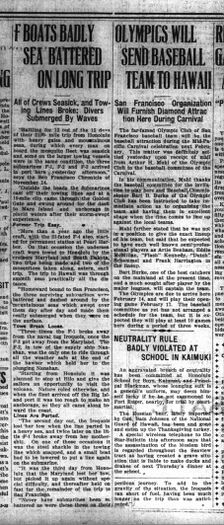General F-class photos: Difference between revisions
Pbcjohnston (talk | contribs) Created General F-class page |
Pbcjohnston (talk | contribs) →After the F-4's loss, 1915: Reformatted clippings |
||
| (13 intermediate revisions by 2 users not shown) | |||
| Line 1: | Line 1: | ||
[[File:F- | [[File:New Header F-class.jpg]] | ||
__TOC__ | |||
<small>Photo in the private collection of Ric Hedman</small> | === The early days, U.S. West Coast and Hawaii === | ||
[[File:F-class and Alert.jpg|left|500px]] | |||
<div style="text-align: justify;"><span style="color:#00008B">This photo was taken at San Diego circa 1913 showing three of the four F-class submarines and the submarine tender [https://www.navsource.org/archives/09/36/3604.htm '''USS Alert (Submarine Tender No. 4)''']. The F-2 and F-1 are the two outboard submarines. The names F-2 and F-1 are seen on the bows. The third, or inboard boat, is the F-3. | |||
The F-4 had been plagued by numerous faults and mechanical failures and equipment shortages since her building and was even delayed her leaving Seattle with the F-3 to join her sisters in San Francisco and later San Pedro. She is still not with the "F-fleet", as they were called, as of the date on this photo taken, most likely, in early 1913. | |||
The F-1 and 2 were built at Union Iron Works in the San Francisco area. The F-3 and 4 were built in Seattle. The F-1 and F-2 had the names placed on the bows. The F-3 and F-4 had the names placed aft of the bow planes, as will be seen in other photos in this archive. This is a difference in style between the building yards. The name placement was later standardized to all the F class having the names on the bows but not until after the "F fleet" had assembled and headed to Hawaii. The Alert went with the submarines to Hawaii. | |||
The New York Sun newspaper reported on January 10, 1913, "...the tender USS Alert and the submarines F-1, F-2 and F-3 were at San Diego...". Another report places them enroute to San Diego on the 13th. That may be the general time frame of this photo. Other newspapers reported on April 6th and again on April 29th, 1913, that the submarine tender USS Alert and the submarines F-1, F-2 and F-3 were at San Pedro. No mention of the F-4 arriving yet. | |||
The F-2, the left-hand boat, is doing a battery charge by running her starboard engine. The exhaust can be seen billowing out from her stern in the photo. | |||
<small>Photo in the private collection of Ric Hedman.</small> | |||
[[File:Red bar sub new.jpg]] | |||
[[File:F-class one and four Alert.jpg|left|500px]] | |||
F-1 and F-4 moored to the starboard side of the USS Alert, San Pedro, CA. The submarines were part of the First Submarine Group of the Pacific Torpedo Flotilla. Photo circa 1912 to 1914. | |||
<small>Photo in the private collection of Ric Hedman.</small> | |||
[[File:Red bar sub new.jpg]] | |||
[[File:F-class with crew in whites.jpg|left|500px]] | |||
All four of the F-class submarines moored together in Hawaii in 1914. The crews are assembled topside in their dress whites. From back to front is the F-1, F-3, F-2 and F-4. The ship in the right background is the [https://www.navsource.org/archives/30/13/13067.htm '''U.S. Army Transport Dix''']. | |||
<small>Photo in the private collection of Ric Hedman.</small> | |||
[[File:Red bar sub new.jpg]] | |||
[[File:F-class three boats.jpg|left|500px]] | |||
A very commonly reproduced photo of the USS F-2, F-1 and the ill-fated F-4 moored, most likely, at Pier 5A in Honolulu Harbor. The photo was between the arrival of the F-class submarines in Hawaii in the July of 1914 and the March 25, 1915 sinking of the F-4. The four F-boats were towed to Hawaii by the cruisers USS South Dakota (Armored Cruiser No. 9) and West Virginia (Armored Cruiser No. 5). | |||
The flat land area seen in the background is Sand Island. The building/lighthouse seen on the left is marking the inner entrance channel to the harbor and is called the [[Harbor Light|'''Honolulu Harbor Light Station''']]. On the right the large building is the Quarantine Dock where ships from overseas were moored until cleared by the health inspectors. When the F-4 was finally raised after her sinking, her first stop was at these docks still hanging from chains under the lifting pontoons while a dry dock was made available. | |||
Pearl Harbor at this time was mainly a coaling station for larger ships. The submarine base and shipyard wasn't ready until 1920 so the submarine fleet moored normally at Piers 5 & 5A near the entrance to Honolulu Harbor. | |||
<small>U.S. Navy photo.</small> | |||
[[File:Red bar sub new.jpg]] | |||
[[File:F-class bows.jpg|left|500px]] | |||
All four F-class submarines moored to the tender USS Alert (AS-4) in Honolulu Harbor, circa early 1915. The F-4 sank on March 25, 1915. This might be one of the last known F-4 photos prior to her loss with all hands. The Alert arrived in Hawaii in early 1915 in company with four K-class submarines. | |||
The ship aft of the Alert is the German unprotected Cruiser SMS Geier that was being pursued by Japanese and British Navy ships and had taken shelter in the neutral port of Honolulu. Claiming engine problems, she needed repair parts from Germany which she couldn't get. She was more or less stranded there until the U.S. entered the war and seized the Geier, renaming her USS Schurz. She was placed into American service for the war effort. | |||
Being a declared neutral port there were legal restrictions on what information could be reported, and the Germans and Japanese both claimed the U.S. had violated this when a radio station in Honolulu had reported the Geier's presence in Honolulu. The Navy censor had not been there at the time to monitor the report. This caused all sorts of international problems. As it turned out later the Geier's crew had broken the room radio room seals placed there by U.S. officials and had transmitted messages that caused legal battles even after WW I had ended. | |||
<small>Photo contributed by MMCM(SS) Rick Larson, USN (Ret.)</small> | |||
[[File:Red bar sub new.jpg]] | |||
[[File:F-class moored together.jpg|left|500px]] | |||
An unfortunately poor quality photo of the F-boats moored together at Honolulu in 1915. The photo looks to have been taken at nearly the same time as the one above, just from a different angle. | |||
<small>Photo in the private collection of Ric Hedman.</small> | |||
[[File:Red bar sub new.jpg]] | |||
<div style="text-align: justify;"><span style="color:#000000"> | |||
=== After the F-4's loss, 1915 === | |||
</div> | |||
[[File:F-class two and three with Alert.jpg|left|500px]] | |||
The USS F-2 and F-3 alongside the USS Alert, a submarine tender. The location is Honolulu Harbor circa 1915. The interned German cruise SMS Geier is moored in the background. | |||
<small>Photo in the private collection of Ric Hedman.</small> | |||
[[File:Red bar sub new.jpg]] | |||
[[File:F-class under crane.jpg|left|500px]] | |||
This wonderful photo comes to us from a contributor in the Netherlands. The photo shows the F-1 and the F-3 moored to what is probably Navy Pier 5. There is a third submarine at the far left but not enough is seen to know if this is the F-2 or the ill-fated F-4. With this unknown it is hard to date the photo though with the crane being so prominent it is a good guess to say it is most likely post March 25, 1915 and prior to November 1915 when the F-class were towed to the mainland. | |||
The floating derrick YD-25 is seen in the background. Efforts to raise the F-4 first utilized this crane but the sunken boat proved too heavy. | |||
Note the shape difference in the fairings over the bow plane mechanism. The F-1 and F-2 were built at Union Iron Works in San Francisco and the F-3 and F-4 were built in Seattle at the Moran Company yards. Just subtle differences in building styles. | |||
Most interestingly is the ship moored at the far right in the photo. This is the interred German unprotected cruiser SMS Geier of the Bussard class. The Geier was in need of engine repairs and coal to fuel her boilers and put into the neutral United States port at Honolulu, Hawaii in October 1914. Unable to get the parts from Germany to repair the engines she remained at Honolulu where she was eventually interred. | |||
After the American entrance into the war in April 1917, the U.S. Navy seized Geier, commissioned her as USS Schurz, and placed her on convoy duty. She was ultimately sunk following a collision with a freighter off the coast of North Carolina, with one man killed and twelve injured. She rests at a depth of 115 feet. | |||
The Geier was armed with ten 4.1 inch guns, one of which can be seen just below and to the left of the lifeboat. The German Naval Ensign is flying from the stern. When the still submerged hulk of the F-4 was towed into the harbor the Geier, along with all the other ships in harbor, lowered her flag to half-mast in tribute. | |||
<small>Photo contributed by Erik van Gemst from The Netherlands.</small> | |||
[[File:Red bar sub new.jpg]] | |||
[[File:F-class under crane 2.jpg|left|500px]] | |||
This interesting photo was most likely taken in late March or April of 1915, during the salvage operations for the F-4. The location is Honolulu Harbor, TH. The large derrick in the background is the Navy floating derrick YD-25. Normally employed for construction activities at the brand-new base under construction at Pearl Harbor, the crane had been moved to Honolulu to support the F-4 salvage. Unfortunately, the sub proved to be too heavy for the crane so lifting pontoons ultimately had to be used. | |||
The two submarines in the foreground are (left to right, despite what the caption says) the F-3 and the F-1. Whether this photo was taken before or after the one above in unknown. There are at least several days between the two images. The location of the crane has moved slightly and there is a difference in the waterline levels of the two submarines. This photo is a little ironic in that just two years later, during night maneuvers off the coast of San Diego, these two boats would collide in the darkness, resulting in the loss of the F-1 and nineteen of her crew. | |||
Seen just to the immediate right of the pipe frame for the F-1 bridge tarpaulins, peeking over the crane barge deck, is the cupola for the Honolulu Harbor Light House with the smaller lantern on its top. To the left side of the F-1 bridge fairwater is an F-1 sailor. He is seen standing behind the torpedo loading ramp. | |||
The large ship in the left background is the German collier SS Locksun that was to supply coal to the German raider SMS Geier. They entered Honolulu several days apart and were not known immediately to be connected. When the U.S. entered WW I the ship and its valuable cargo of coal was seized and commissioned into the USN as the USS Gulfport. She was decommissioned and sold in 1922. | |||
Note the confusion of the person hand printing, backwards, with white ink on the negative, trying to make the letters look correct. | |||
<small>Photo in the private collection of Ric Hedman.</small> | |||
[[File:Red bar sub new.jpg]] | |||
[[File:F-class remaining three.jpg|left|500px]] | |||
The three remaining F-class submarines after the sinking of the F-4. They are moored at the Navy Piers in Honolulu Harbor on what appears to be a calm sunny morning. The lighthouse on Sand Island can be seen in the background. The crews are cleaning the submarines up for a Captain's Inspection. The three submarines were prohibited from diving after the pressure hull collapsed on the F-4, until the exact cause of the disaster could be determined. A group of five or six young men sit and watch the activity. They were probably curious about submarines in the wake of the F-4's sinking. The submarines were later towed back to the mainland, being replaced by the newer and more reliable K-class submarines. | |||
<small>Photo in the private collection of Ric Hedman.</small> | |||
[[File:Red bar sub new.jpg]] | |||
[[File:F-class and Maryland.jpg|left|500px]] | |||
In this photo are the remaining submarines of the F-class after the sinking of the F-4. They are, left to right, the F-1, F-2 and F-3. They are moored to Pier 5 in Honolulu Harbor. The USS Maryland (Armored Cruiser No. 8) is moored at the left to pier 5A. | |||
The date is in question since Maryland was at Honolulu several times during this 1915 time frame. One was bringing the six specially made pontoons used to raise the F-4 from the ocean floor just off Honolulu Harbor. Later she had help tow the replacement K-class submarines to Hawaii. She later towed the F-3 back to California. The collier Nanshan and the tug Iroquois towed the F-l and the F-2 respectively. The presence of the three F-class narrows the timing. We believe this photo is the earlier visit after transporting the pontoons. | |||
The F-3 has forward tanks emptied and aft trim probably flooded to have so much of an up angle, as her bow is much higher than her sisters' bows. No doubt there was considerable maintenance being done to these submarines in the aftermath of the F-4 sinking. The three remaining submarines were prohibited from diving until they had all been thoroughly overhauled and re-certified. To do this they needed to be returned to the mainland. Their overhauls to be completed at Mare Island Naval Shipyard. | |||
In 1915 the well known Naval Station Pearl Harbor was in it's infancy. Major work was still going on to build the facility and a large amount of dredging still needed to be done to the shallow harbor. Because of this, most naval activity in Hawaii was centered in Honolulu Harbor, down the coast to the east a few miles. | |||
<small>Photo in the private collection of Ric Hedman.</small> | |||
[[File:Red bar sub new.jpg]] | |||
<center> | |||
<gallery mode="nolines" perrow=3 widths="550px" heights="650px"> | |||
File:F-class newspaper 1.jpg | |||
File:F-class newspaper 2.jpg | |||
</gallery> | |||
</center> | |||
<small>Clippings from the Honolulu Star-Bulletin, September 1915.</small> | |||
[[File:Red bar sub new.jpg]] | |||
[[File:F-class two and three in drydock.jpg|left|500px]] | |||
The F-2 and F-3 in the Inter Island Company Drydock in Honolulu Harbor, September or October 1915. The drydocks at the Pearl Harbor Navy Yard had not been completed, so the Navy was forced to rent this drydock from a private company. The salvaged submarine F-4 was moved from this drydock and taken to Pearl Harbor and left on the bottom in Magazine Loch for future disposal to get these two submarines into it. The F-2 took the brunt of the collision with the USS Supply when she lost power while trying to maneuver into the pier alongside the submarines. The two subs are bow to bow. The F-3 is in the rear and the F-2 is closest to the camera. | |||
<small>Photo in the private collection of Ric Hedman.</small> | |||
[[File:Red bar sub new.jpg]] | |||
<div style="text-align: justify;"><span style="color:#000000"> | |||
=== Back to the U.S. West Coast === | |||
</div> | |||
<center> | |||
<gallery mode="packed" perrow=3 widths="450px" heights="350px"> | |||
File:F-class HSB 28 Oct 1915 pg 2 Clip.jpg | |||
File:F-class towing HSB 22 Nov 1915 pg 5 Clip.jpg | |||
File:VEN 8 Nov 1915 pg 1 Clip.jpg | |||
File:VEN 13 Nov 1915 pg 8 Clip.jpg | |||
</gallery> | |||
</center> | |||
<div style="text-align: justify;"><span style="color:#00008B">Four newspaper clippings outlining the perilous voyage for the F-boats back to the mainland. Since they didn't have the range to make the voyage their selves, they made it under tow. The seas were rough and the tows broke several times. The three boats made it, but the crews were worn out and the boats in bad shape by the time they raised San Francisco. | |||
<small>First two clippings from the Honolulu Star-Bulletin and the next two from the Vallejo Evening News, via Newspapers.com, courtesy of Darryl Baker.</small> | |||
[[File:Red bar sub new 2.jpg]] | |||
[[File:F-class drydock.jpg|left|500px]] | |||
The F-2 and F-1 in drydock at the Mare Island Navy Yard in Vallejo, CA., late 1915 or early 1916. They underwent a thorough overhaul after the towing operation from Hawaii. | |||
<small>Photo in the private collection of Ric Hedman.</small> | |||
[[File:Red bar sub new.jpg]] | |||
[[File:F-class nest 1.jpg|left|500px]] | |||
The F-1, F-3, and F-2 moored together in a nest somewhere on the U.S. west coast, approximately 1916-1917. | |||
<small>Photo courtesy of Mike Dilley, whose father, Homer Dilley, sailed aboard the F-2.</small> | |||
[[File:Red bar sub new.jpg]] | |||
[[File:F-class nest 2.jpg|left|500px]] | |||
Another photo of the F-class nest shown above, taken from a higher angle. The boats all have their torpedo loading hatches open. F-2 has additional decking installed around her periscope shears to provide additional space for bridge watchstanders. | |||
<small>Photo courtesy of Mike Dilley, whose father, Homer Dilley, sailed aboard the F-2.</small> | |||
[[File:Red bar sub new.jpg]] | |||
[[File:3 F-boats.jpg|left|500px]] | |||
<div style="text-align: justify;"><span style="color:#00008B">The three remaining F-class submarines, most likely at Mare Island for inspection and repair, circa 1916. After the sinking of the F-4 the remaining F-class boats were ordered back to the mainland to be examined and overhauled before they would be permitted to dive again. | |||
The right-hand submarine has had panels removed from both sides of its conning tower fairwater, exposing all the systems within it. She also has a deck plate propped up to access equipment within the superstructure. | |||
The middle and left-hand submarines have had the superstructure removed over their engine mufflers and exhausts for some sort of maintenance. | |||
<small>Photo courtesy of Mike Dilley, whose father, Homer "Pat" Dilley sailed aboard the USS F-2.</small> | |||
[[File:Red bar sub new.jpg]] | [[File:Red bar sub new.jpg]] | ||
Latest revision as of 20:02, 17 April 2025
The early days, U.S. West Coast and Hawaii
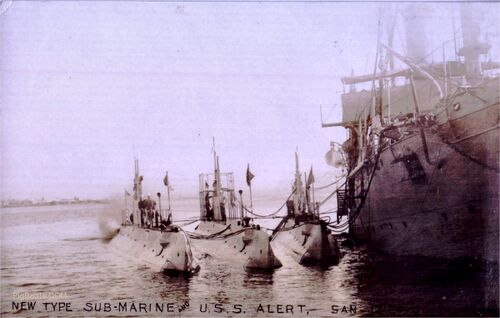
The F-4 had been plagued by numerous faults and mechanical failures and equipment shortages since her building and was even delayed her leaving Seattle with the F-3 to join her sisters in San Francisco and later San Pedro. She is still not with the "F-fleet", as they were called, as of the date on this photo taken, most likely, in early 1913.
The F-1 and 2 were built at Union Iron Works in the San Francisco area. The F-3 and 4 were built in Seattle. The F-1 and F-2 had the names placed on the bows. The F-3 and F-4 had the names placed aft of the bow planes, as will be seen in other photos in this archive. This is a difference in style between the building yards. The name placement was later standardized to all the F class having the names on the bows but not until after the "F fleet" had assembled and headed to Hawaii. The Alert went with the submarines to Hawaii.
The New York Sun newspaper reported on January 10, 1913, "...the tender USS Alert and the submarines F-1, F-2 and F-3 were at San Diego...". Another report places them enroute to San Diego on the 13th. That may be the general time frame of this photo. Other newspapers reported on April 6th and again on April 29th, 1913, that the submarine tender USS Alert and the submarines F-1, F-2 and F-3 were at San Pedro. No mention of the F-4 arriving yet.
The F-2, the left-hand boat, is doing a battery charge by running her starboard engine. The exhaust can be seen billowing out from her stern in the photo.
Photo in the private collection of Ric Hedman.
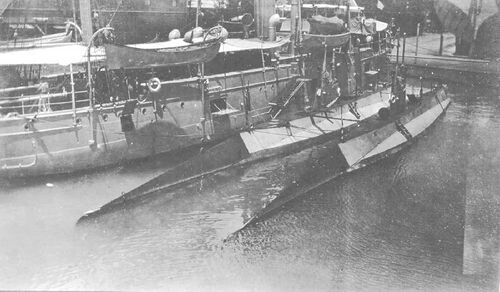
F-1 and F-4 moored to the starboard side of the USS Alert, San Pedro, CA. The submarines were part of the First Submarine Group of the Pacific Torpedo Flotilla. Photo circa 1912 to 1914.
Photo in the private collection of Ric Hedman.
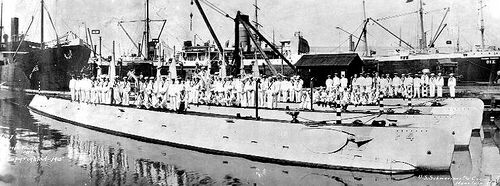
All four of the F-class submarines moored together in Hawaii in 1914. The crews are assembled topside in their dress whites. From back to front is the F-1, F-3, F-2 and F-4. The ship in the right background is the U.S. Army Transport Dix.
Photo in the private collection of Ric Hedman.
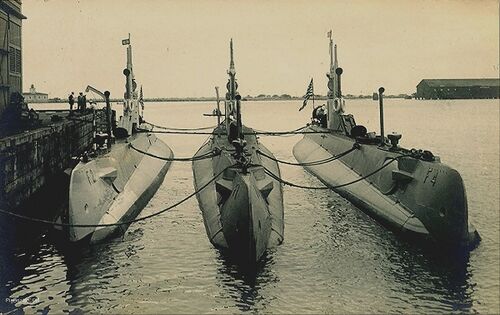
A very commonly reproduced photo of the USS F-2, F-1 and the ill-fated F-4 moored, most likely, at Pier 5A in Honolulu Harbor. The photo was between the arrival of the F-class submarines in Hawaii in the July of 1914 and the March 25, 1915 sinking of the F-4. The four F-boats were towed to Hawaii by the cruisers USS South Dakota (Armored Cruiser No. 9) and West Virginia (Armored Cruiser No. 5).
The flat land area seen in the background is Sand Island. The building/lighthouse seen on the left is marking the inner entrance channel to the harbor and is called the Honolulu Harbor Light Station. On the right the large building is the Quarantine Dock where ships from overseas were moored until cleared by the health inspectors. When the F-4 was finally raised after her sinking, her first stop was at these docks still hanging from chains under the lifting pontoons while a dry dock was made available.
Pearl Harbor at this time was mainly a coaling station for larger ships. The submarine base and shipyard wasn't ready until 1920 so the submarine fleet moored normally at Piers 5 & 5A near the entrance to Honolulu Harbor.
U.S. Navy photo.
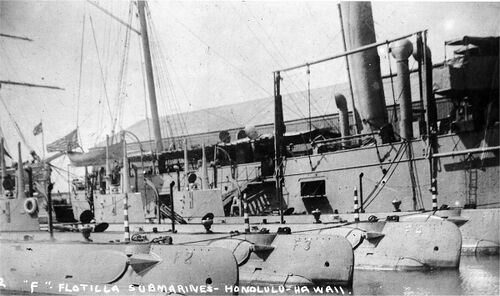
All four F-class submarines moored to the tender USS Alert (AS-4) in Honolulu Harbor, circa early 1915. The F-4 sank on March 25, 1915. This might be one of the last known F-4 photos prior to her loss with all hands. The Alert arrived in Hawaii in early 1915 in company with four K-class submarines.
The ship aft of the Alert is the German unprotected Cruiser SMS Geier that was being pursued by Japanese and British Navy ships and had taken shelter in the neutral port of Honolulu. Claiming engine problems, she needed repair parts from Germany which she couldn't get. She was more or less stranded there until the U.S. entered the war and seized the Geier, renaming her USS Schurz. She was placed into American service for the war effort.
Being a declared neutral port there were legal restrictions on what information could be reported, and the Germans and Japanese both claimed the U.S. had violated this when a radio station in Honolulu had reported the Geier's presence in Honolulu. The Navy censor had not been there at the time to monitor the report. This caused all sorts of international problems. As it turned out later the Geier's crew had broken the room radio room seals placed there by U.S. officials and had transmitted messages that caused legal battles even after WW I had ended.
Photo contributed by MMCM(SS) Rick Larson, USN (Ret.)
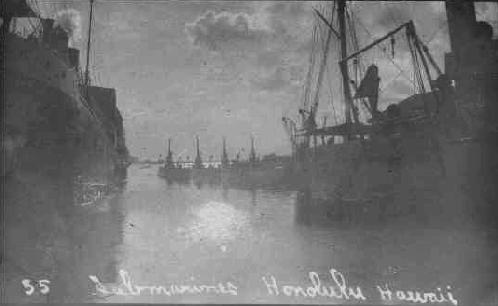
An unfortunately poor quality photo of the F-boats moored together at Honolulu in 1915. The photo looks to have been taken at nearly the same time as the one above, just from a different angle.
Photo in the private collection of Ric Hedman.
After the F-4's loss, 1915
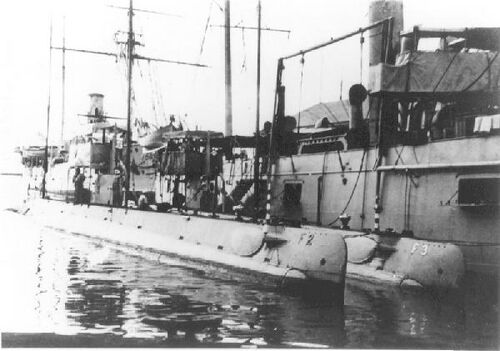
The USS F-2 and F-3 alongside the USS Alert, a submarine tender. The location is Honolulu Harbor circa 1915. The interned German cruise SMS Geier is moored in the background.
Photo in the private collection of Ric Hedman.
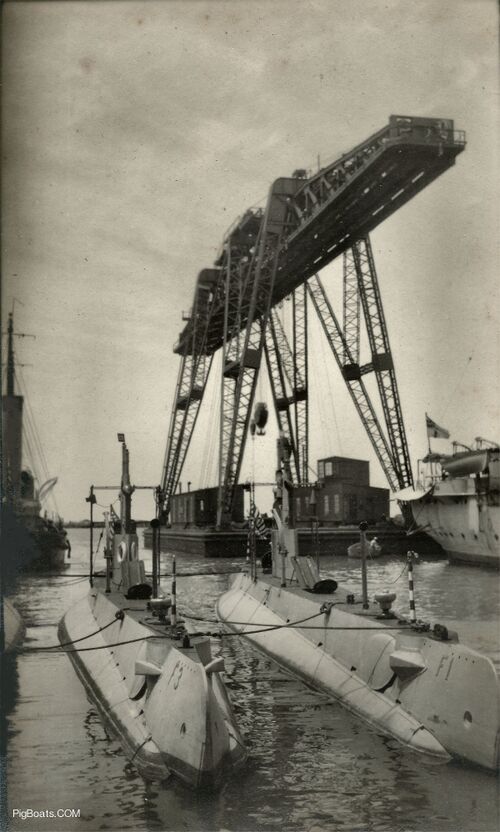
This wonderful photo comes to us from a contributor in the Netherlands. The photo shows the F-1 and the F-3 moored to what is probably Navy Pier 5. There is a third submarine at the far left but not enough is seen to know if this is the F-2 or the ill-fated F-4. With this unknown it is hard to date the photo though with the crane being so prominent it is a good guess to say it is most likely post March 25, 1915 and prior to November 1915 when the F-class were towed to the mainland.
The floating derrick YD-25 is seen in the background. Efforts to raise the F-4 first utilized this crane but the sunken boat proved too heavy.
Note the shape difference in the fairings over the bow plane mechanism. The F-1 and F-2 were built at Union Iron Works in San Francisco and the F-3 and F-4 were built in Seattle at the Moran Company yards. Just subtle differences in building styles.
Most interestingly is the ship moored at the far right in the photo. This is the interred German unprotected cruiser SMS Geier of the Bussard class. The Geier was in need of engine repairs and coal to fuel her boilers and put into the neutral United States port at Honolulu, Hawaii in October 1914. Unable to get the parts from Germany to repair the engines she remained at Honolulu where she was eventually interred.
After the American entrance into the war in April 1917, the U.S. Navy seized Geier, commissioned her as USS Schurz, and placed her on convoy duty. She was ultimately sunk following a collision with a freighter off the coast of North Carolina, with one man killed and twelve injured. She rests at a depth of 115 feet.
The Geier was armed with ten 4.1 inch guns, one of which can be seen just below and to the left of the lifeboat. The German Naval Ensign is flying from the stern. When the still submerged hulk of the F-4 was towed into the harbor the Geier, along with all the other ships in harbor, lowered her flag to half-mast in tribute.
Photo contributed by Erik van Gemst from The Netherlands.
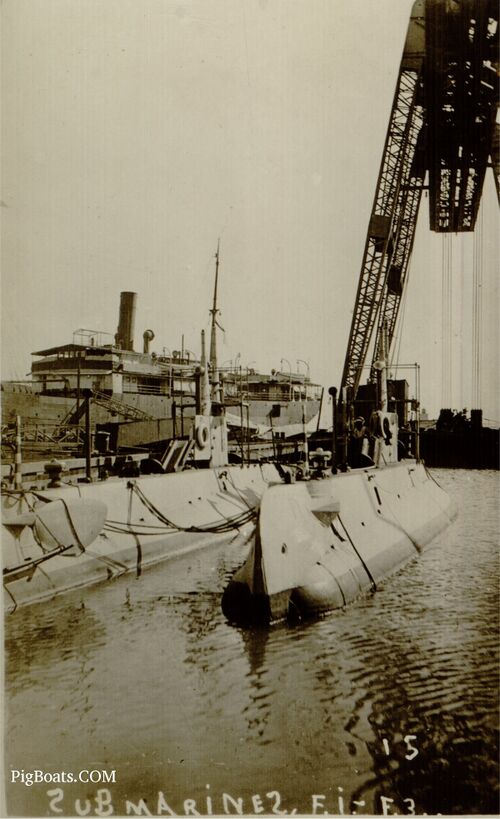
This interesting photo was most likely taken in late March or April of 1915, during the salvage operations for the F-4. The location is Honolulu Harbor, TH. The large derrick in the background is the Navy floating derrick YD-25. Normally employed for construction activities at the brand-new base under construction at Pearl Harbor, the crane had been moved to Honolulu to support the F-4 salvage. Unfortunately, the sub proved to be too heavy for the crane so lifting pontoons ultimately had to be used.
The two submarines in the foreground are (left to right, despite what the caption says) the F-3 and the F-1. Whether this photo was taken before or after the one above in unknown. There are at least several days between the two images. The location of the crane has moved slightly and there is a difference in the waterline levels of the two submarines. This photo is a little ironic in that just two years later, during night maneuvers off the coast of San Diego, these two boats would collide in the darkness, resulting in the loss of the F-1 and nineteen of her crew.
Seen just to the immediate right of the pipe frame for the F-1 bridge tarpaulins, peeking over the crane barge deck, is the cupola for the Honolulu Harbor Light House with the smaller lantern on its top. To the left side of the F-1 bridge fairwater is an F-1 sailor. He is seen standing behind the torpedo loading ramp.
The large ship in the left background is the German collier SS Locksun that was to supply coal to the German raider SMS Geier. They entered Honolulu several days apart and were not known immediately to be connected. When the U.S. entered WW I the ship and its valuable cargo of coal was seized and commissioned into the USN as the USS Gulfport. She was decommissioned and sold in 1922.
Note the confusion of the person hand printing, backwards, with white ink on the negative, trying to make the letters look correct.
Photo in the private collection of Ric Hedman.
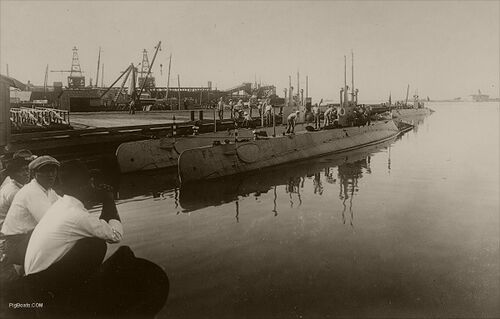
The three remaining F-class submarines after the sinking of the F-4. They are moored at the Navy Piers in Honolulu Harbor on what appears to be a calm sunny morning. The lighthouse on Sand Island can be seen in the background. The crews are cleaning the submarines up for a Captain's Inspection. The three submarines were prohibited from diving after the pressure hull collapsed on the F-4, until the exact cause of the disaster could be determined. A group of five or six young men sit and watch the activity. They were probably curious about submarines in the wake of the F-4's sinking. The submarines were later towed back to the mainland, being replaced by the newer and more reliable K-class submarines.
Photo in the private collection of Ric Hedman.
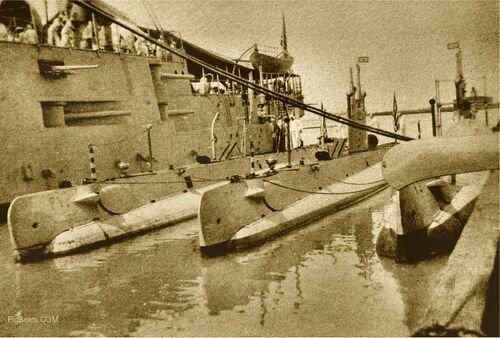
In this photo are the remaining submarines of the F-class after the sinking of the F-4. They are, left to right, the F-1, F-2 and F-3. They are moored to Pier 5 in Honolulu Harbor. The USS Maryland (Armored Cruiser No. 8) is moored at the left to pier 5A.
The date is in question since Maryland was at Honolulu several times during this 1915 time frame. One was bringing the six specially made pontoons used to raise the F-4 from the ocean floor just off Honolulu Harbor. Later she had help tow the replacement K-class submarines to Hawaii. She later towed the F-3 back to California. The collier Nanshan and the tug Iroquois towed the F-l and the F-2 respectively. The presence of the three F-class narrows the timing. We believe this photo is the earlier visit after transporting the pontoons.
The F-3 has forward tanks emptied and aft trim probably flooded to have so much of an up angle, as her bow is much higher than her sisters' bows. No doubt there was considerable maintenance being done to these submarines in the aftermath of the F-4 sinking. The three remaining submarines were prohibited from diving until they had all been thoroughly overhauled and re-certified. To do this they needed to be returned to the mainland. Their overhauls to be completed at Mare Island Naval Shipyard.
In 1915 the well known Naval Station Pearl Harbor was in it's infancy. Major work was still going on to build the facility and a large amount of dredging still needed to be done to the shallow harbor. Because of this, most naval activity in Hawaii was centered in Honolulu Harbor, down the coast to the east a few miles.
Photo in the private collection of Ric Hedman.
Clippings from the Honolulu Star-Bulletin, September 1915.
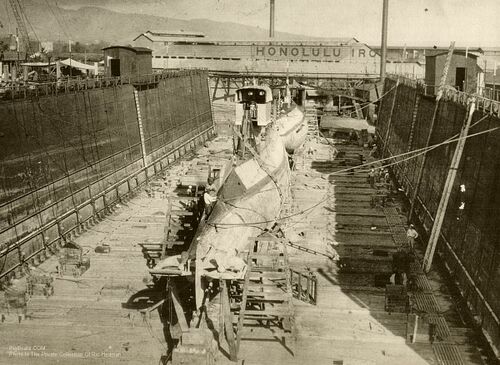
The F-2 and F-3 in the Inter Island Company Drydock in Honolulu Harbor, September or October 1915. The drydocks at the Pearl Harbor Navy Yard had not been completed, so the Navy was forced to rent this drydock from a private company. The salvaged submarine F-4 was moved from this drydock and taken to Pearl Harbor and left on the bottom in Magazine Loch for future disposal to get these two submarines into it. The F-2 took the brunt of the collision with the USS Supply when she lost power while trying to maneuver into the pier alongside the submarines. The two subs are bow to bow. The F-3 is in the rear and the F-2 is closest to the camera.
Photo in the private collection of Ric Hedman.
Back to the U.S. West Coast
First two clippings from the Honolulu Star-Bulletin and the next two from the Vallejo Evening News, via Newspapers.com, courtesy of Darryl Baker.
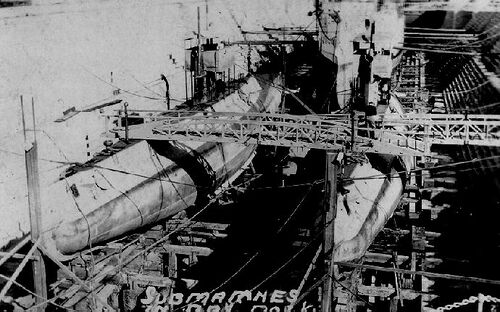
The F-2 and F-1 in drydock at the Mare Island Navy Yard in Vallejo, CA., late 1915 or early 1916. They underwent a thorough overhaul after the towing operation from Hawaii.
Photo in the private collection of Ric Hedman.
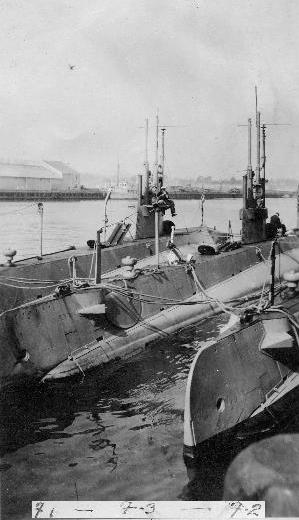
The F-1, F-3, and F-2 moored together in a nest somewhere on the U.S. west coast, approximately 1916-1917.
Photo courtesy of Mike Dilley, whose father, Homer Dilley, sailed aboard the F-2.
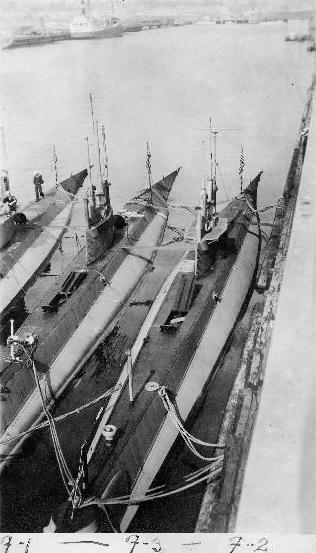
Another photo of the F-class nest shown above, taken from a higher angle. The boats all have their torpedo loading hatches open. F-2 has additional decking installed around her periscope shears to provide additional space for bridge watchstanders.
Photo courtesy of Mike Dilley, whose father, Homer Dilley, sailed aboard the F-2.
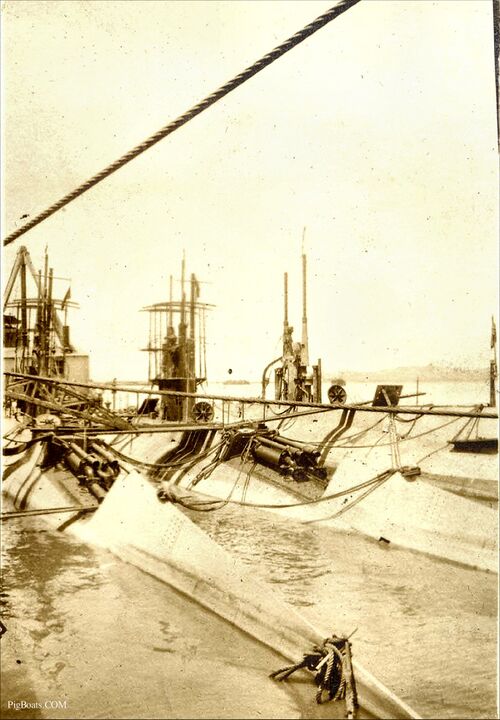
The right-hand submarine has had panels removed from both sides of its conning tower fairwater, exposing all the systems within it. She also has a deck plate propped up to access equipment within the superstructure.
The middle and left-hand submarines have had the superstructure removed over their engine mufflers and exhausts for some sort of maintenance.
Photo courtesy of Mike Dilley, whose father, Homer "Pat" Dilley sailed aboard the USS F-2.
Page created by:
Ric Hedman & David Johnston
1999 - 2023 - PigBoats.COM©
Mountlake Terrace, WA, Norfolk, VA
webmaster at pigboats dot com




